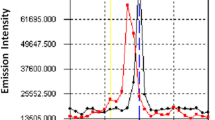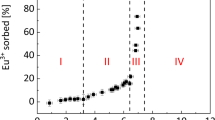Abstract
A simple, rapid, effective and eco-friendly decomposition method is developed for the determination of uranium (U) by laser induced fluorimetry (LIF). The salts of sodium di-hydrogen phosphate (NaH2PO4) and di-sodium hydrogen phosphate (Na2HPO4) were used in the ratio of 1:1 (phosphate flux) for the decomposition and dissolution of refractory, non silicate minerals like ilmenite, rutile, columbite, tantalite, and xenotime. The effect of associated matrix elements (Ti, Fe, Nb, Ta, Mn and Y present in the sample) on quenching of uranyl fluorescence was studied. The flux used for the sample decomposition has several advantages. In the reported sample decomposition methods, α-hydroxy acids are used as complexing agents to prevent hydrolysis and to get clear and stable solution. This solution can not be directly used for U determination by LIF as α-hydroxy acids quench uranyl fluorescence, hence separation is required. In the present method no such separation is required. The flux itself acts as fluorescence enhancing reagent and buffer (maintaining the optimum pH of 7.1 ± 0.1). The fused melt of the flux mixture, when disintegrated in water, gives clear and stable solution and has high tolerance for most of inorganic quenchers compared to reported phosphate buffers. Also just by dilution (due to high sensitivity of LIF), the concentration of quenchers could be brought down well within the tolerance limit. The accuracy and precision of the method was evaluated by analyzing Certified Reference Materials (IGS-33 and IGS-34 of Institute of Geological Sciences, UK) and Synthetic Minerals. The accuracy of the data is further evaluated by comparing with standard decomposition methods. The results are well within the experimental error. The RSD of the method is ±10% (n = 6) at 10 ppm level for Ilmenite and for other minerals the RSD of the method is ±5% (n = 6) at 50 ppm level. The method is being routinely applied to various refractory samples received from Rare Metal and Rare Earth Investigations for determination of uranium by laser fluorimetry.
Similar content being viewed by others
References
Gupta CK, Suri AK (1994) Extractive metallurgy of niobium. CRC Press, Boca Raton, p 21
Onishi H (1989) Photometric determination of trace metals, part IIB. Wiley, New York, p 608
Balaji BK, Premdas A, Ramanaiah GV (1984) Talanta 31(10A):846
Satyanarayana K (2002) At Spectrosc 23(3):77
Palei PN (1970) Analytical chemistry of elements—uranium. Science Publisher, Ann Arbor, p 137
Negi RS, Singh AK, Malhotra RK (1983) In Proceedings of 20th annual convention of chemists, Cuttack, India, p 30
Radhamani R, Murugesan P, Premdas A, Srivastava PK (2007) Talanta 71:1932
Mahanta PL, Hanuman VV, Radhamani R, Srivastava PK (2008) At Spectrosc 29(5):172
Schoeller WR, Powell AR (1955) The analysis of minerals and ores of the rare elements. Charles Griffin and Co., London, p 119
Srivastava PK, Singh AK, Kumar BS (2003) At Spectrosc 24(3):98
Malhotra RK, Tikoo BN (1988) Proceedings of the Fifth National Symposium of Indian Society of Analytical Scientists, Hyderabad, India
Premdas A, Srivastava PK (1999) J Radioanal Nucl Chem 242(1):23
Acknowledgements
The authors are thankful to Dr. M. K. Roy, Regional Director, Shri Amit Majumdar, Dy. Regional Director and Dr K. Satyanarayana, Head Chemistry Group, for providing infra structural facilities. The authors wish to thank Shri K. Umamaheswar, Additional Director (R&D) and Shri P. B. Maithani Additional Director (OP-I) for their constant encouragement to carry out the R&D work. We thank Shri Anjan Chaki, Director, AMD for his keen interest and constant encouragement in uranium related applied research work and for kind permission to publish this work in journal. The suggestions given by Shri P. K. Srivastava are gratefully acknowledged.
Author information
Authors and Affiliations
Corresponding author
Rights and permissions
About this article
Cite this article
Radhamani, R., Mahanta, P.L., Murugesan, P. et al. Novel fusion method for direct determination of uranium in ilmenite, rutile, columbite, tantalite, and xenotime minerals by laser induced fluorimetry. J Radioanal Nucl Chem 285, 287–292 (2010). https://doi.org/10.1007/s10967-010-0579-4
Received:
Published:
Issue Date:
DOI: https://doi.org/10.1007/s10967-010-0579-4




